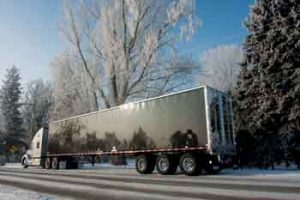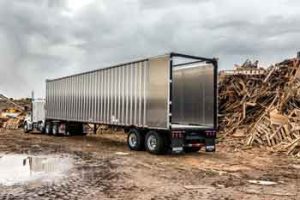Depending on the job, there could be more than one trailer that will meet your needs.
By Dan Taylor

Those in the industry know the important role semi-trailers have in the refuse business—from being able to move more volume to the landfills to helping keep collection trucks on the route where they are most efficient. Through my years of experience when meeting with a customer, most have an idea of the trailer type they need for the particular job they are on. Depending on the job, there could be more than one trailer that will meet your needs. What does the transfer station or stations you haul out of look like? What type of trailer will give you the highest volume given the weight and length law in your jurisdiction?
Drop Center Tipper Trailers
Drop center tipper trailers offer more capacity than a comparable flat floor trailer. A typical 48′ drop center trailer has 22 cubic yards more capacity. This added capacity allows the trailer to get up to weight with less load compaction, which in turn adds up to less trailer damage, making the drop center trailer the most efficient way to move trash for the transfer station to the landfill.
Walking Floor® and Live Floor™
Walking Floor® and Live Floor™ trailers are another way to move trash from a transfer station the land fill; generally, they come into use when landfills do not have tipping available. These floor systems use a hydraulic cylinder mounted either at the front or under the floor to self-unload the trailer on average in six to seven minutes. This system generally is powered by a tractor mounted PTO and pump system.

Tarping Systems
Tarping systems vary customer to customer and sometimes job to job. For driver retention, we are seeing most of our customers moving away from the traditional manual roll over and flip tops for load containment. We are seeing 85 percent of customers using some type of powered tarping system with everything from electric flip tops and roll over tarps to hydraulic options. Powered tarping systems are dramatically lowering driver injuries due to the repetitive motion of opening and closing the tarp. We think that 100 percent of the trailers in the very near future will have some type of powered system.
Flat Floor Hard Top
Flat floor compactor trailers are generally built with a hard top instead of a fabric tarping system due the nature of the loading and the possibility of some load spring back. These trailers are generally offered as tipper and Live Floor™ or Walking Floor® configurations. Being a compactor trailer, they can get up to maximum weight each time they are loaded with minimal trailer damage. Over the life of the trailer, the hard top will save thousands in tarp system repairs and maintenance.
Optimizing Trailer Configuration
Options to consider include tire inflation systems to keep the tires at the optimum tire pressure at all times and get the most life out the tires possible. We have had customers tell us these systems pay for themselves in the first year in added tire wear.

Photos courtesy of Western Trailers.
Extended wheel-end warranty and semi-viscus grease also help lower maintenance cost. If you take the time and let your trailer sales representative know exactly what you are doing with the trailers, they can make your trailer work as hard as you do.
If you are bidding a new job or part of a new transfer station going in, I highly recommend that you get your trailer supplier involved. To make sure you have the clearances to efficiently move around the station with the optimized equipment you are planning on. Your trailer supplier should also be well-versed in the weight and length laws in the area that you are operating in to maximize trailer payload. | WA
Dan Taylor is the Director of Sales for Western Trailers (Boise, ID). Dan has been with Western Trailers for 35 years working in various positions from production, area sales representative, sales manager and director of sales. Dan can be reached at (888) 344-2539 or e-mail [email protected].
